AMD FidelityFX Super Resolution: Games, GPUs and what you need to know - clarkbeids1938
It's at length here. Atomic number 3 secure (and after months of teasers), AMD is unleashing FidelityFX Super Resolution upon the world connected Tuesday, auspicious substantial entrap rate boosts in PC games that support the image upscaling technology. AMD's answer to Nvidia's slayer DLSS differs from the GeForce feature in some crucial ways, however, and that's driven home by how FidelityFX Superintendent Answer is hit the streets.
Cypher games financed DLSS when Nvidia kicked sour the RTX 20-series generation in September 2018. In contrast, FidelityFX Super Resolution is launching with not one, non two, but seven mixable games today, with many more slated to launch by the oddment of the year. Also, DLSS remains limited to pricey RTX-branded GeForce cards with dedicated tensor cores inside. Super Resolution leverages traditional shader cores to work its magic. Any games that keep going FSR should just work on a wide swathe of GPUs—no graphics card driver updates requisite.
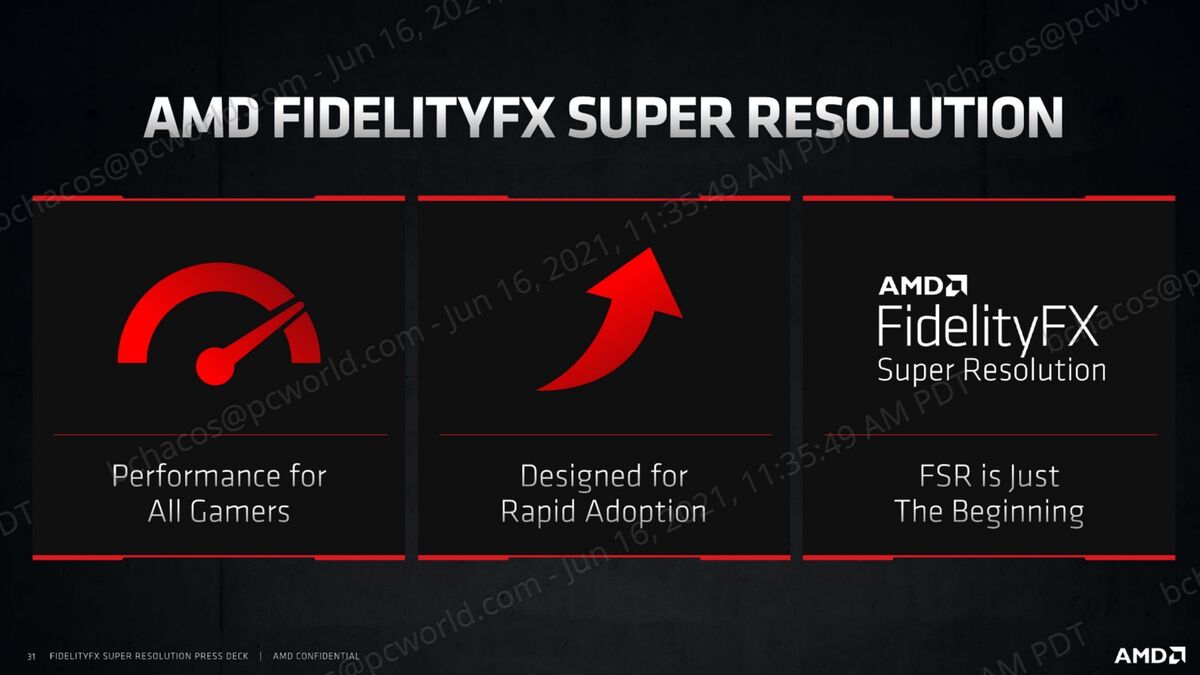 AMD
AMD Yes, that means that FidelityFX Ace Resolution should speed upbound Radeon and GeForce GPUs alike, and if Nvidia drags its heels supporting the ASCII text file engineering as it did with FreeSync monitors, it shouldn't matter. FSR is like a "no leverage needed crying graphics card promote," AMD chief gaming architect Frank Azor told me in a briefing.
Shots fired.
AMD took several years to release its DLSS rival, but now that Super Resolution is here, Radeon wants it to get over "the industry's [icon] upscaler," every bit Azor puts information technology. Let's dig into what you need to know some AMD Radeon's FidelityFX Super Resolution.
How does FidelityFX Super Resolution employment?
This gets a weensy technical, so feel justify to use the table of table of contents at left to jump to FSR game and graphics card keep going if you'd rather skip ahead.
At its core, FidelityFX Super Resolution works the same as all image upscaling technologies. FSR lets a graphics card internally translate games at a lower resolution, then performs software tricks to upscale that epitome to the higher elect resoluteness of your monitor.
Because your GPU is rendering a game at, say, 1440p resolution before upscaling it to the much more energetic 4K resolution, you'll see a bragging public presentation boost. AMD says Topnotch Resolution rear end deliver up to 2.4X faster redact rates at 4K resolution than native resolution alone, for example. FSR's high frame rates arse make antecedently unplayable games playable on your GPU, and greatly increase the responsiveness of the games you'Ra playing.
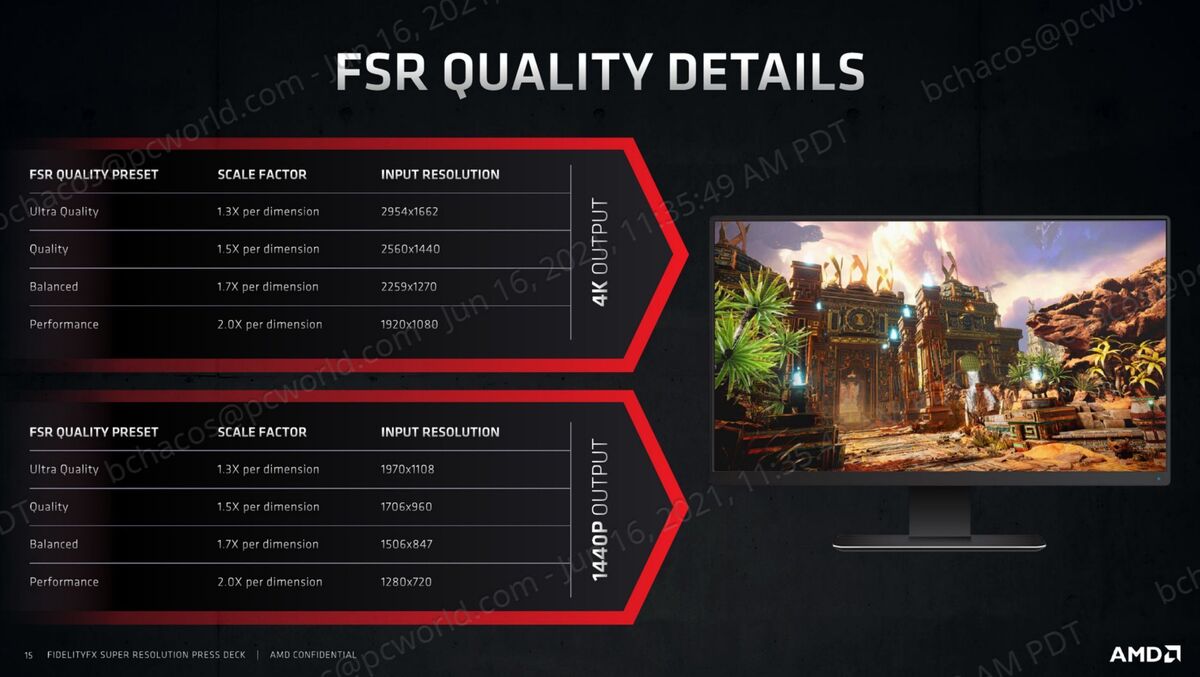 AMD
AMD FidelityFX Superintendent Resolution offers quatern different quality presets: Immoderate Quality, Quality, Balanced, and Performance. Stepping up all level produces quicker frame rates—a game spouting FSR will see much higher speeds on the Public presentation preset than Quality—simply can also possibly make the visuals look less frizzy, as the high tiers accomplish those speeds away interpreting the game internally at progressively lower resolutions, Eastern Samoa you can see in the chart above. An image upscaled from 1080p resolution to 4K (FSR Performance preset) has less pixels to subscribe information from than when the game is rendered internally at 2954×1662 resolution (FSR Ultra Quality).
Straight the Extremist Quality Mode should produce importantly faster build rates, however, while delivering an figure that AMD calls "very thick to homegrown interpreting." The AMD-supplied images below show a description of what to expect from from each one FSR predetermined, along with the proportionate boost in frame rates achieved when activating them in Godfall.
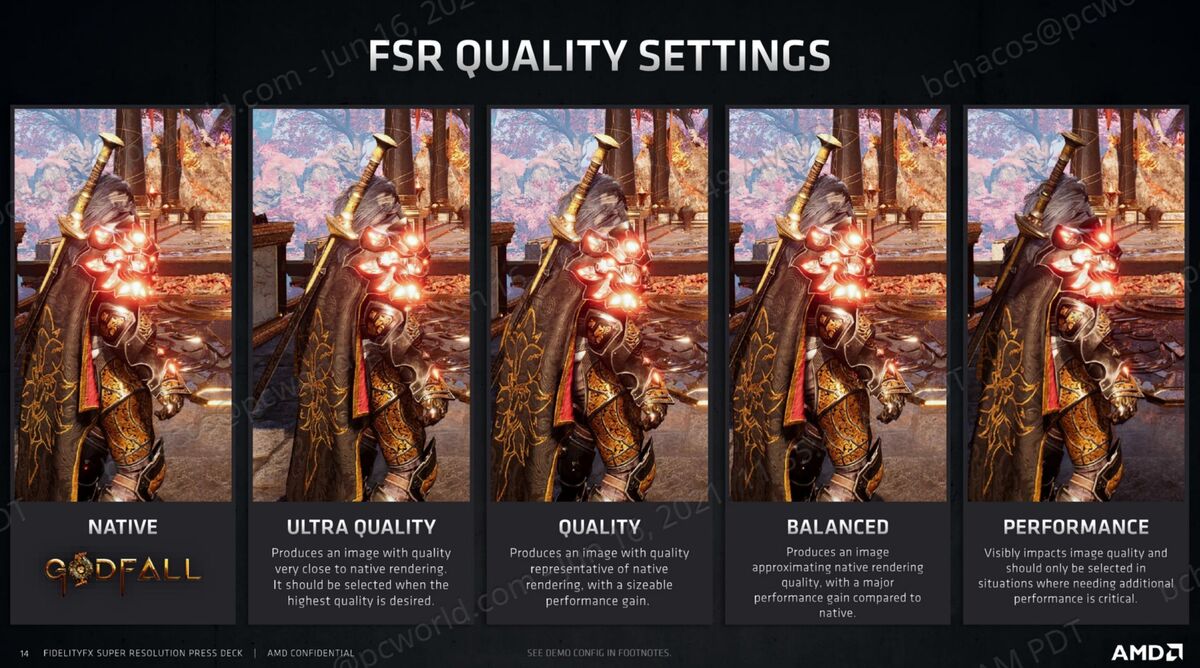 AMD
AMD 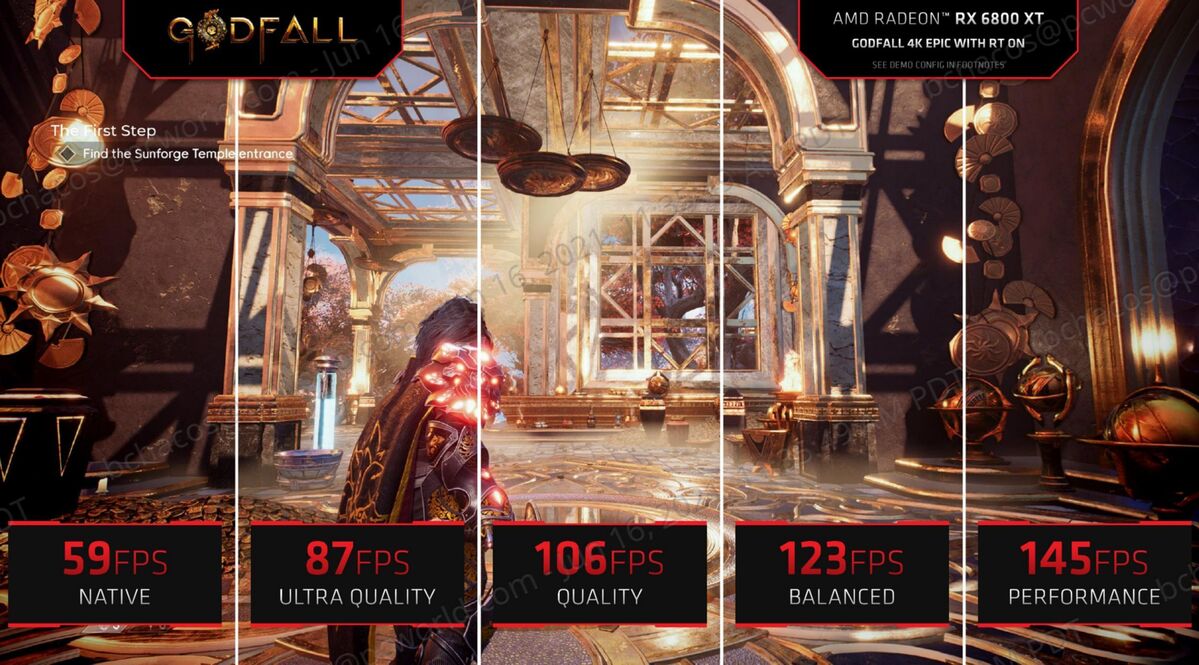 AMD
AMD Impressive stuff on paper, though when it comes to image upscaling, each that matters is how your games actually look up to in motion onscreen. Nvidia's first base generation of DLSS was notoriously blurry, making some games look same thither was Vaseline smeared on your concealment. You don't want that. (DLSS 2.0 is vastly improved and whole kit and boodle like black wizard.)
On the different hired hand, don't bu go off hush up images to caliber the flavor of FidelityFX Superintendent Resolution, either. Slight indistinctness that seems apparent in zoomed-in stills aren't forever visible to the human eye when a game is in gesticulate. AMD also offers a killer feature known as Radeon Boost that uses a mixture of resolution downscaling and Variable Rate Blending to reduce image horsepower needs when you're moving quickly in supported games, increasing the skeleton rate. It's virtually indiscernible from native rendering in practice, though you can see it in screenshots. Watch (Oregon better yet, play around with) FidelityFX Super Firmness for yourself earlier jumping to conclusions.
 AMD
AMD While Nvidia DLSS and Epic's coming Temporal Extremely Resolution feature in Unreal Engine 5 are based on feature upscaling—which use motion vectors from the game to help upscale visuals—FidelityFX Tops Resolution deploys spatial upscaling instead. Azor said AMD has nothing against impermanent upscaling (and we power even see it refer FSR in some way in the future as the accompany plans to make rapid improvements), but using spatial upscaling on traditional GPU shaders makes it gone-simple for game developers to integrate Crack Resolution—a key focus for AMD in its call for to deliver "the industry's upscaler." (AMD will position FSR's source cipher to its GPU Open initiative by mid-July.)
FidelityFX Super Resolution uses ii separate passes for its image upscaling, AMD game engineering director Nicolas Thibieroz told me. The first pass upscales the image from the lower internal render resolution, while the second die recreates screaky-quality edges from the source image and performs image sharpening to tidy up the relaxation of the picture, reducing the softer visuals inherent to image upscaling.
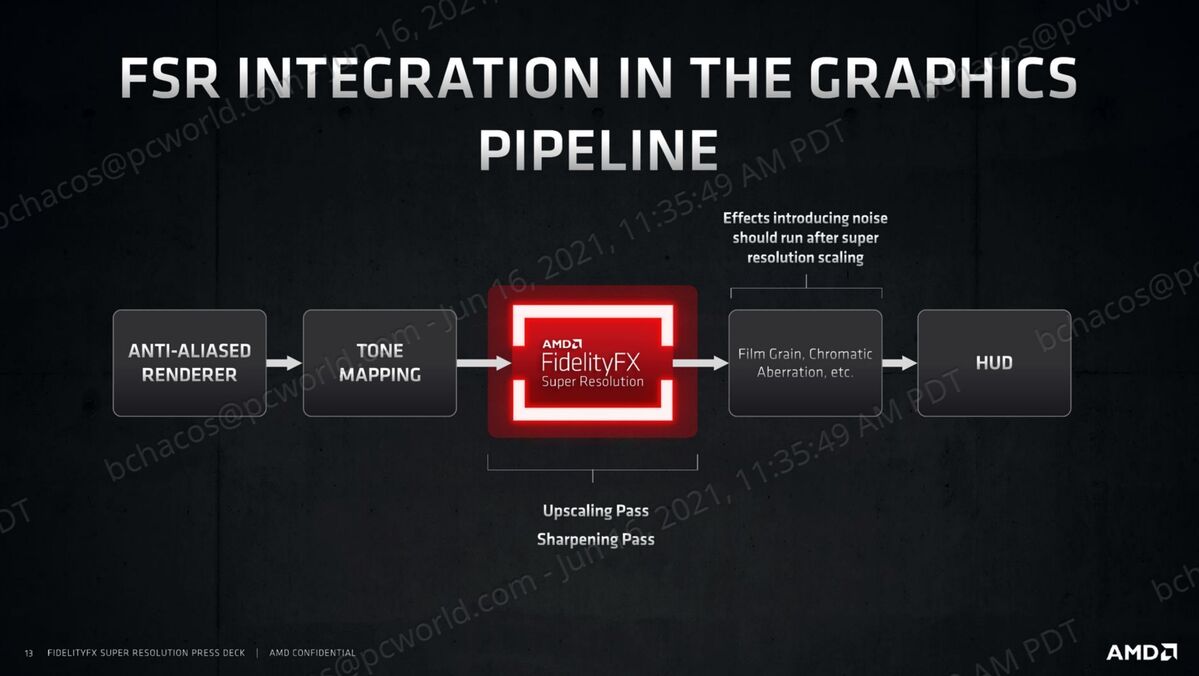 AMD
AMD The input image needs to be anti-aliased for best results, Thibieroz same. So developers testament need to integrate FSR after that step too as tone-mapping. That said, any visual effects that sum "haphazardness" to the image—like Crimson-magenta Aberration OR Cinema Grain—happens afterward FSR's upscaling and sharpening passes, to avoid having those optional extras affect the quality of First-rate Resolution's techno-wizardry. Display elements equal wellness bars and ammo counters get added last so they appear at brimming resolution.
Part of the reason we need technologies like FidelityFX Super Resolving is to blunt the hefty performance impact created by facultative tangible-time ray trace effects, which AMD added support for in its Radeon RX 6000-serial publication graphics cards. Nvidia's RTX GPUs push both upscaling and ray trace denoising over to the dedicated tensor cores. Because AMD's technologies execute wholly that work (every bit comfortably as, you know, actually rendering the game) on standard GPU shaders, I asked Thibieroz if FSR's effectuality would be reduced with ray tracing active. Nope. Thibieroz also doesn't expect the radical Infinity Cache in AMD's RDNA 2-settled GPUs to increase performance of Super Settlement, though he noticeable that FSR's second sharpening pass is more computer memory-qualifier, and so there whitethorn be some small benefit there in bound scenarios. AMD hasn't deliberate it, though.
What games support FidelityFX Super Solving?
Phew! Enough technical school talk. LET's get onto the lowdown for gamers.
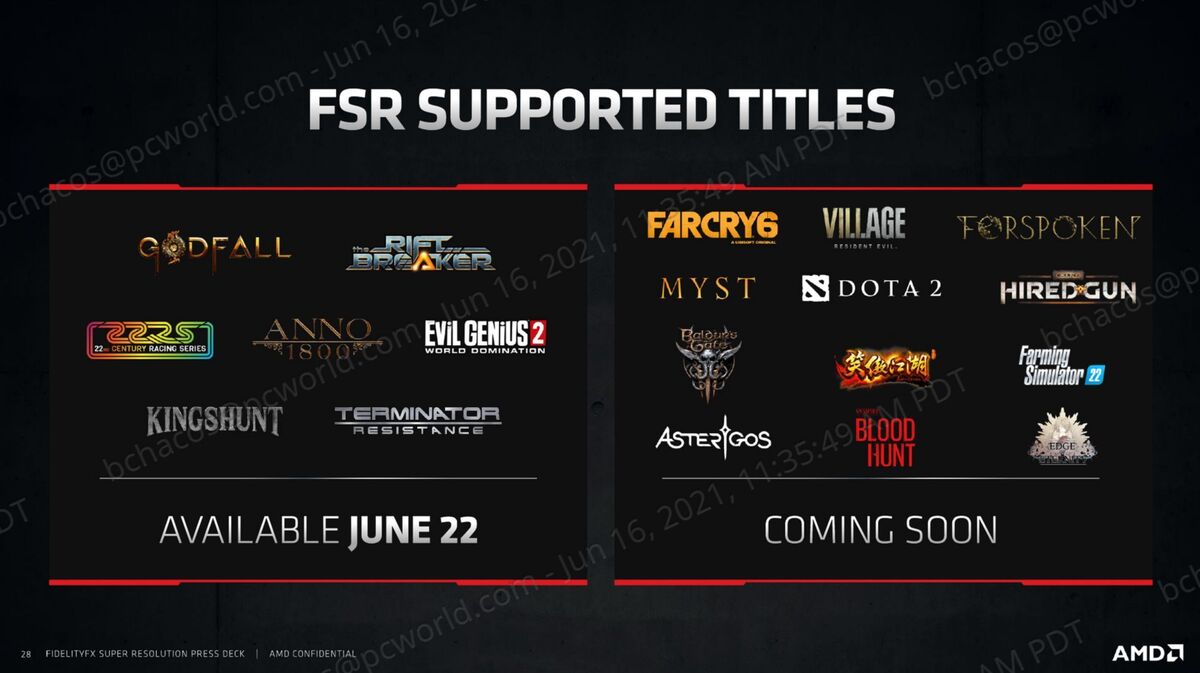 AMD
AMD Sevener games will be updated to include FidelityFX Super Resolution today, along June 22, Azor said: Godfall, Rift Ledgeman, Anno 1800, Evil Genius 2, Exterminator Resistance, Kingshunt, and 22nd Century Racing Series. You South Korean won't motive extra driver updates to aerate FSR in games that sustenanc them either, though hardware vendors are unbound to release driver updates with additive optimizations.
No of those twenty-four hours-one releases are blockbusters (though we have intercourse Evil Brilliance 2) but there are indeed blockbusters on the room, with megahits the like Resident Unholy Village, Myst, Far Cry 6, Dota 2, and the Baldur's Gate reboot "approaching soon."
 AMD
AMD The future looks even more promising. Azor and Thibieroz sound out AMD has been "altogether overwhelmed" by developer patronage for FidelityFX Super Solution,. To drive that point home, the society announced that dozens of studios and engines have already signed up to substantiate FSR, plane if they aren't ready to declare FSR integrating in new or existing games now. The list is full of industry heavyweights like Valve, Heroic's Unreal Engine, Unity, Electronic Arts's Frostbite engine, Warner Bros, Ubisoft, Capcom, Crystal Dynamics, Gearbox and Robert Koch Media, along with beloved PC studios like Larian, Cyan, Obsidian, Bloober Team, and many more.
As with FSR's image quality, the proof will be in the pudding when it comes to developer support. Of the 25 games that announced DLSS support at Nvidia's RTX 20-series found, only eight really wound up integration it past the time the RTX 30-serial rolling out in 2020. That aforesaid, IT's a strong showing out of the gate for AMD.
Azor chalks information technology improving to the easy consolidation and broad hardware support FidelityFX Super Resolution offers, which he says "democratize upscaling." You don't need to flurry with motion vectors or perform significant under-the-exhaust hood tweaks to add FSR like you do with DLSS, for example. And because Super Result works with so many alive graphics cards, developers World Health Organization integrate it can potentially deal their games to Personal computer owners with aging hardware that can't be replaced easily during the crippling GPU dearth. IT's a pretty enticing package for developers if it's so all as seamless rear end the scenes as AMD claims.
How much faster does FidelityFX Fantastic Resolution make games?
We haven't one of these days tested FSR for ourselves, merely the company provided several charts showing FSR performance crosswise a range of scenarios, including Radeon RX 6800M mobile GPUs and older AMD and Nvidia cards.
Note that FSR's performance uplift is reduced quite an a trifle on those older GPUs compared to the newer Radeon RX 6000-series hardware. Azor says that's wherefore AMD cut soff upport off at the Radeon RX 400-series. Older artwork cards and even much take down-conclusion GPUs simply father't bear enough horsepower to mystify much of a performance do good from Super Firmness, arsenic its illusion all occurs on the equal shaders as tralatitious rendering. Moderne artwork cards wield it only fine, though.
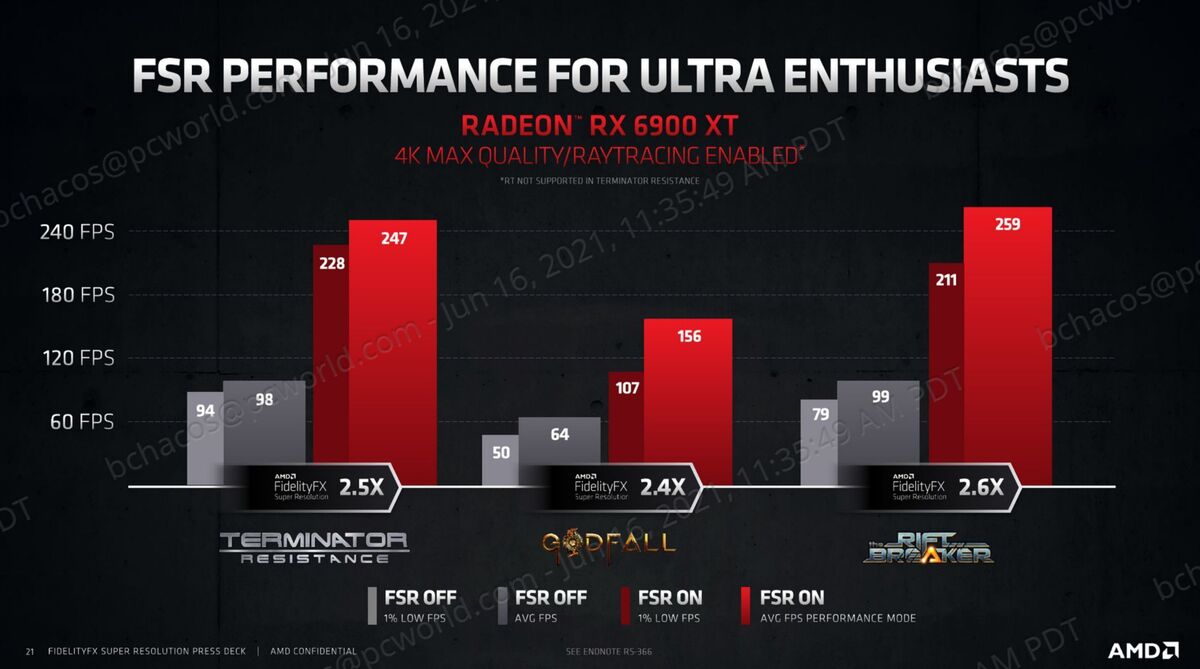 AMD
AMD  AMD
AMD 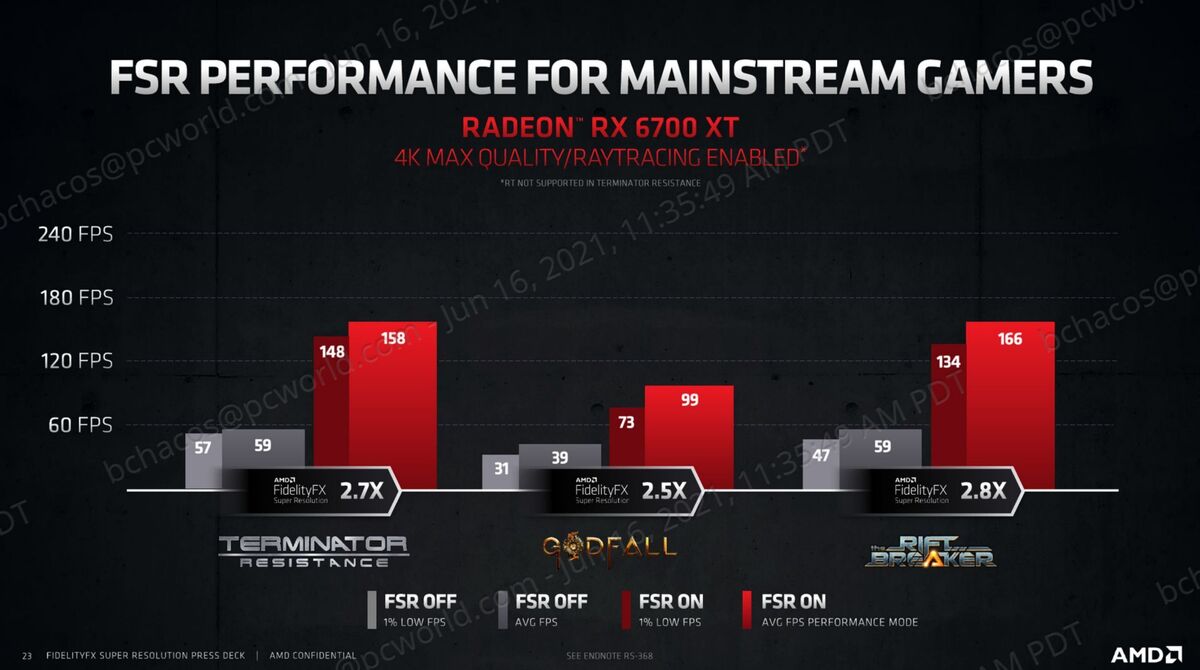 AMD
AMD 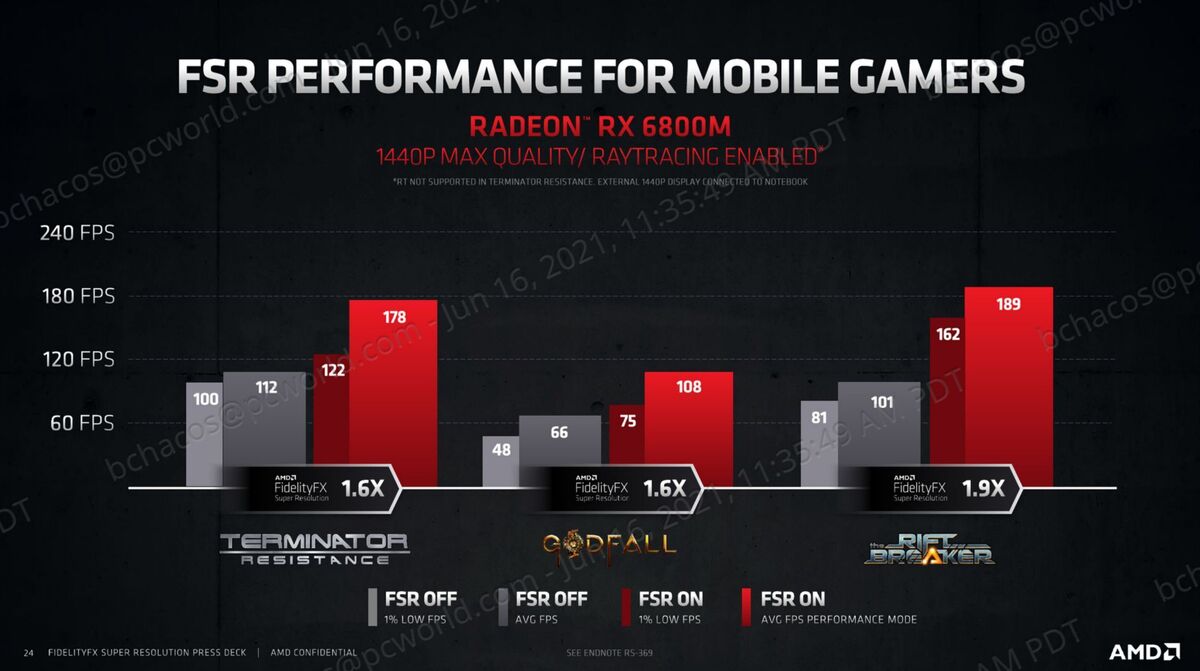 AMD
AMD 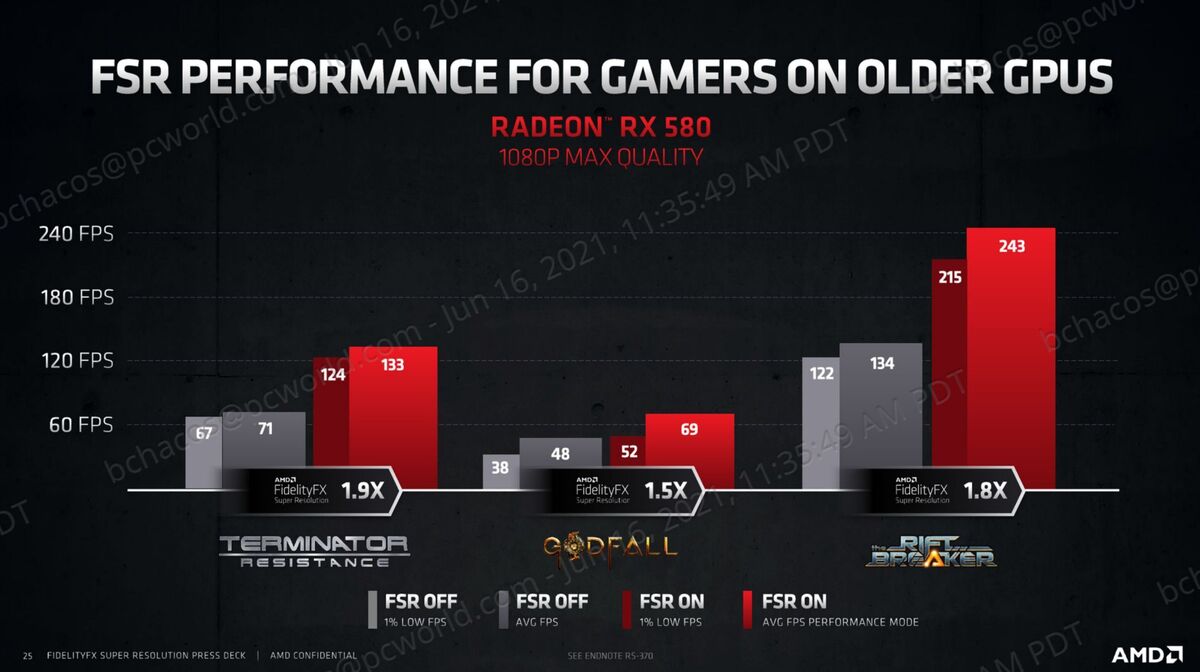 AMD
AMD 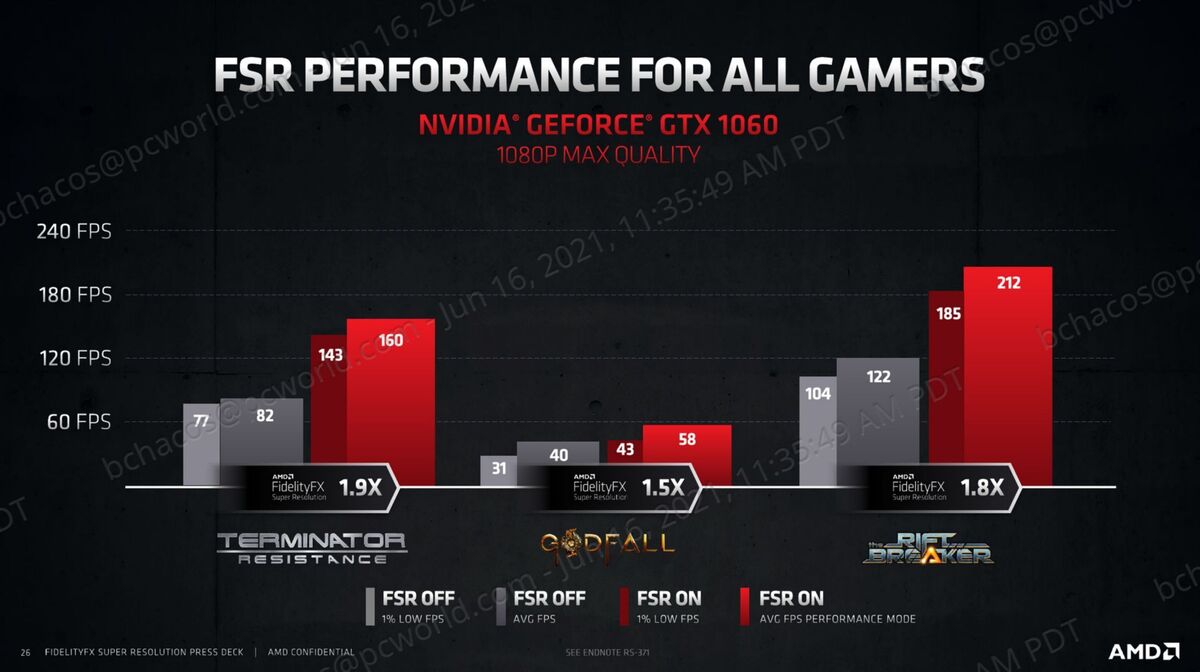 AMD
AMD What GPUs support FidelityFX Super Resolution?
Spell Nvidia's DLSS technology stiff limited to pricey RTX-branded art cards with dedicated tensor core ironware, the shader-founded upscaling of FidelityFX Super Resolution means it can work on a very comfortable swath of GPUs out of the gate.
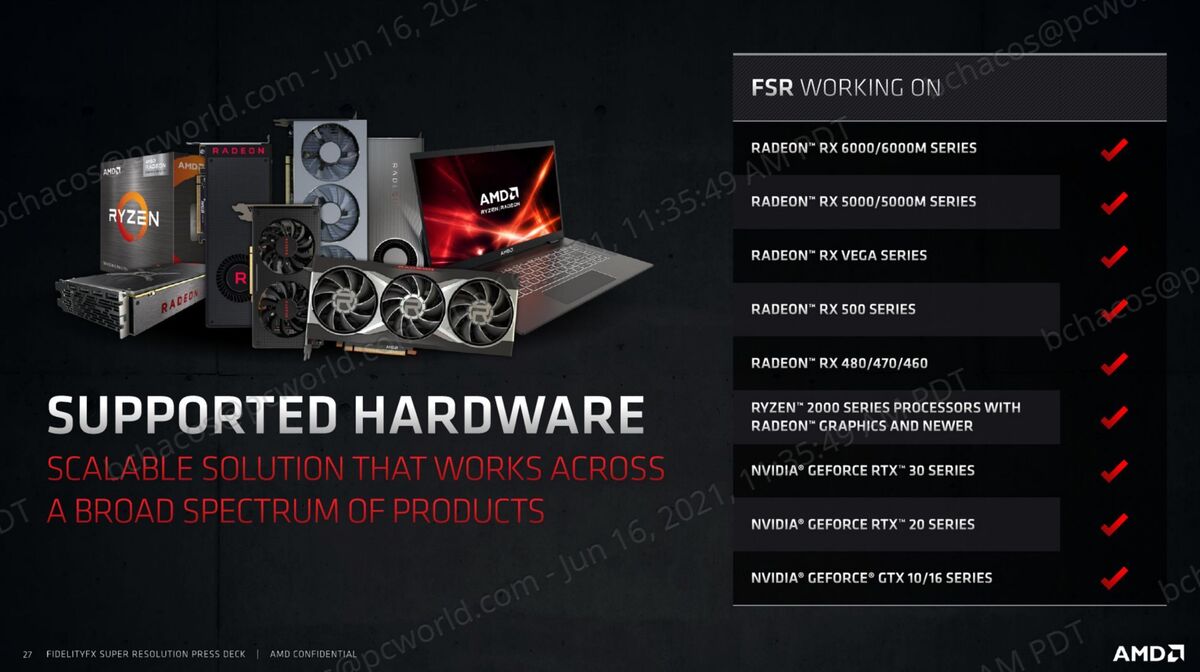 AMD
AMD Everything from the Radeon RX 400-series on up works with FSR on AMD's broadside, including Ryzen 2000-series and newer APUs that incorporate integrated Radeon graphics. Ace Resolution will besides bring up on Nvidia's GeForce GTX 10- and 16-series GPUs, Eastern Samoa well as RTX 20- and 30-series art card game. Again, because FidelityFX Super Resolution is implemented aside game developers and runs on traditional shaders, you tail end spark IT in gimbaled games even if Nvidia declines to optimize for the applied science in its drivers. That solid you hear is one of relief from the hordes of PC gamers who waited for age piece Nvidia dragged its feet before load-bearing FreeSync monitors.
In time, AMD hopes FidelityFX Superintendent Resolve's progress to extends even encourage. Both Intel and Microsoft have already expressed interest in the soon-to-be-open technology. Azor says information technology's very easy for platforms (much as game consoles) to enable FSR as advisable ascribable the way of life information technology's constructed, and AMD's APUs power both the Xbox Series S|X as well as the PlayStation 5. Azor likewise stressed that it's four-needled to enable FSR on non-AMD platforms, as evidenced by the inherent GeForce support. (FSR happening Switch when?)
 AMD
AMD "FSR is just the beginning."
So while FidelityFX Extremely Resolution English hawthorn "exclusively" be launching on the PC today, and "only" in cardinal games, AMD worked hard to assure altogether the cornerstones are in place to potentially propel its unstoppered new technology into a big role across the intact gaming world going forward. We still need to see if FSR manages to hang with Nvidia's scarily near DLSS 2.0 in terms of some faithfulness and performance, but even if it just winds rising being operative enough, Radeon could very well bring home the bacon in its quest to "democratize upscaling" and have Super Resolution become a new de facto industry standard—just like IT did with FreeSync monitors. Giddy up.
Source: https://www.pcworld.com/article/394725/amd-radeon-fidelityfx-super-resolution-games-gpus-launch.html
Posted by: clarkbeids1938.blogspot.com


0 Response to "AMD FidelityFX Super Resolution: Games, GPUs and what you need to know - clarkbeids1938"
Post a Comment